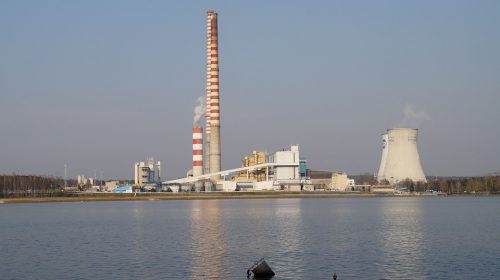A dramatic drop in worldwide planned coal power in 2016 could put climate goals “within feasible reach,” as long as nations do not slacken their efforts.
So says a new report from a group of green campaigners that want to end the use of coal as a fuel. The group includes Greenpeace, the Sierra Club, and CoalSwarm.
 The report says 2016 saw a dramatic decline in planned coal power worldwide.
The report says 2016 saw a dramatic decline in planned coal power worldwide.
Image: Rybnik coal power station, Poland, pixabay-308316
The 2017 report says that in 2016 there was a 48 percent fall in planned coal power plants and a 62 percent reduction in new construction starts.
It maintains that the main reason for the rapid decline in planned coal power is the shift in energy policies in Asia.
China and India coal slowdown ‘has global implications’
China is clamping down on new coal plant projects, while backers for coal plants in India are showing increasing reluctance to invest, note the authors.
Between the two countries there are now over 100 coal power projects where construction is frozen.
There has also been an 85 percent drop in the number of permits granted by the Chinese government to build new coal plants.
Given that China and India account for 86 percent of coal power built between 2006 and 2016, “the slowdown in these two countries carries global implications,” they add.
Outside of Asia, the last two years have also seen record levels of outdated coal plant retirements – totalling some 64 gigawatts. These have mainly occurred in Europe and the United States.
The report suggests that combining these two factors – reduction in planned coal power and increase in outdated coal plant retirements – could put the climate goal of keeping the rise in global temperature no higher than 2°C above the pre-industrial level “within feasible reach.” That is, as long as countries keep up their efforts.
Turning point
Lauri Myllyvirta, senior global campaigner on Coal and Air Pollution at Greenpeace says 2016 represents a turning point, because during the year:
“China all but stopped new coal projects after astonishing clean energy growth has made new coal-fired power plants redundant, with all additional power needs covered from non-fossil sources since 2013.”
She also notes that, during 2016, Belgium and Ontario in Canada stopped using coal for energy entirely, three G8 countries announced timescales for phasing out coal, while old plant closures – such as in the U.S. and Europe – have driven major reductions in emissions.
Coal industry says coal will remain essential for decades
Meanwhile, commenting on the report, the coal industry says that contrary to the picture it portrays, coal will remain essential to economic growth and development in India and Southeast Asia for decades.
Benjamin Sporton CEO of World Coal Association, points out that: “China’s climate pledge suggests that coal will continue to be central to its energy solutions albeit through efficiencies including the use of new coal technologies.”
Also, turning to India, he notes that: “The IEA [International Energy Agency] has said that India’s coal demand will see the biggest growth over next five years with annual average growth rate of 5 percent by 2021.”

